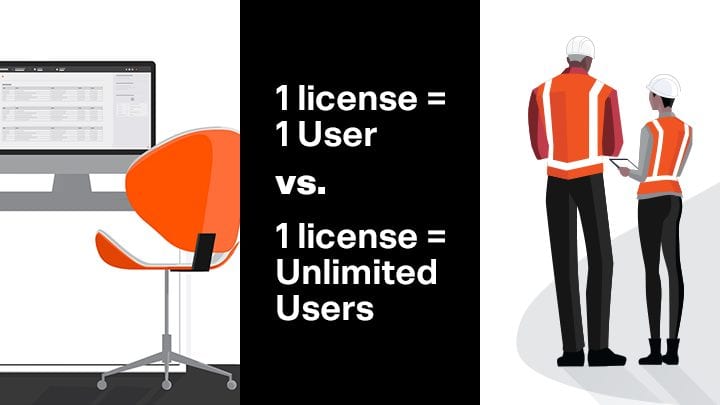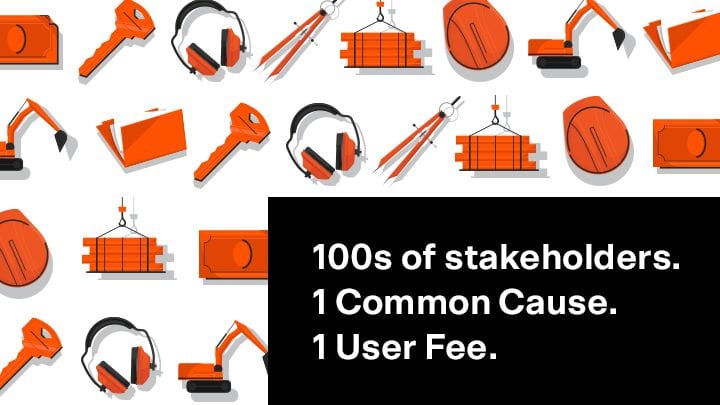When pricing a thing or a service, we assign it a useful transactional number that can be accepted, rejected, or negotiated. In the case of a service, how does the asking price (fee) fairly represent a greater or lesser use of that service? In construction technology, construction management solutions put this question to the test.
Since most of these digital construction management solutions take the form of subscription-based Software as a Service (SaaS)—versus investment in capex like bulldozers or opex like concrete and rebar—the challenge is to come up with a model that allows pricing to flex with the purchaser’s changing usage of the service. Construction management technologies—and the measurable efficiencies they deliver—continue to see increased adoption by the construction industry.
Let’s look at some common pricing models for capital planning or construction software.
Square Footage as a Pricing Metric
Some construction management SaaS providers charge the user according to how many square feet they manage, or are constructing. As a measure of “how much” the software will be used in the build, this makes intuitive sense. The problem is, while total square footage as a determinant of price may make sense for the relatively straightforward ground-up construction of a new building, that total square footage figure will continue to determine the future service fee even for sporadic, smaller-scale post-completion work required for the life of the building.

A capital improvement renovation or maintenance instance dealing with a small portion of the original build years down the line will pay a SaaS fee based on the total square footage of the project as originally stipulated in the service agreement. While the square footage-based fee model may have elements that attempt to accommodate these post-completion use-cases, the fact is that the ongoing fee is ultimately—to one degree or another—determined by the brute square footage of the original project. This is a sort of one-size-forever fee arrangement that seems almost to penalize for the size of the original build.
Additionally, not all ground-up construction projects are created equal; a train station, a power plant, and a condo building might have similar square footages but dramatically different construction costs and complexities.
One Worker, One Fee: Individual Seat Licensing
Another common pricing model in the construction technology market is commonly known as the Seat License. This model requires the company to purchase—for each individual user of the technology—a separate user license. The term “Seat License” and the pricing model itself date back to a time when working at a computer necessarily meant you were sitting in a seat. This pricing model may well be as antiquated as that definition of a digital worker.
In the epoch when each computer worker was dedicated to a discrete computing station, this pricing model made some sense. Today, the seat license model infers that all users on a construction project will be equally engaged, and that there will be no overlap or confluence of each other’s project responsibilities. Mobile technologies have in fact brought digital collaboration out of the “seat” and into the field.

Construction management technology today is all about transparency, fluidity of movement in a project, and collaboration. The one-license-per-individual model ignores these facts. In practice, the individual license model could mean that a skilled expert who needs to make a brief and concise contribution to the project will be charged the same as the construction manager whose use will encompass the entire lifecycle of the project.
A construction project is a dynamic work environment that requires many different professional disciplines to collaborate—in a myriad of contexts and with varying degrees of involvement.
The individual license is blind to these user distinctions. The architect on a project may need to occasionally visit the digital platform in order to review work or answer questions, while the project manager is working in the platform every day. A one-size-fits-all seat license will never give a fair accounting of actual use by the individual users and adds as many line items to the project ledger as there are users on a project. This can lead to moving a license from worker to worker to keep project costs in check—a shell game that adds unnecessary complication to the project and actively hampers collaboration.
License to Breathe Easier: Unlimited Users and Productivity
A service fee based on capital spend—the amount you’re spending to get a project completed—is a fee based on Annual Construction Volume, or ACV. This pricing model—which allows unlimited users on your projects—is expressly designed to offer your capital projects the freedom to staff appropriately, with no graduated licensing impact to budget.
The ACV model’s single service fee is based on the volume of construction a company commissions and manages in the digital platform on an annual basis. Once those annual construction volume figures are established, the license becomes an umbrella that covers everyone the project owner wishes, however many people the project requires. Licenses may be assigned to, or removed from, designated users as the license holder sees fit during project progress. If a specialty trade needs to make brief use of the software for her project role, she is simply added to the license and provided those gated permissions necessary to her work.

The ACV model offers the openness, fluidity, and collaboration that typify today’s successful construction project. Whether your project requires 5, 50, or 500 users of the technology, you’re covered under the ACV model. The unlimited license model plays to the strengths of the interconnected world of modern construction. The more workers given the ability to work in a single platform, the more granular the platform’s project data—a pool of rich information from which useful strategic truths may be extracted for the next build. And the next.
The project owner wants to know that the investment is sound, the line items comprehensible, and the risk minimal. Bringing all project players under a single user license grants the collective project workforce unfettered use of the platform, and simplifies for the owner both the buy and the measurable ROI.
Leave a Reply